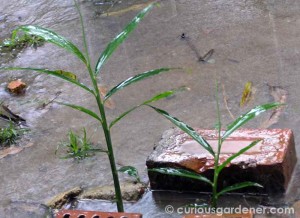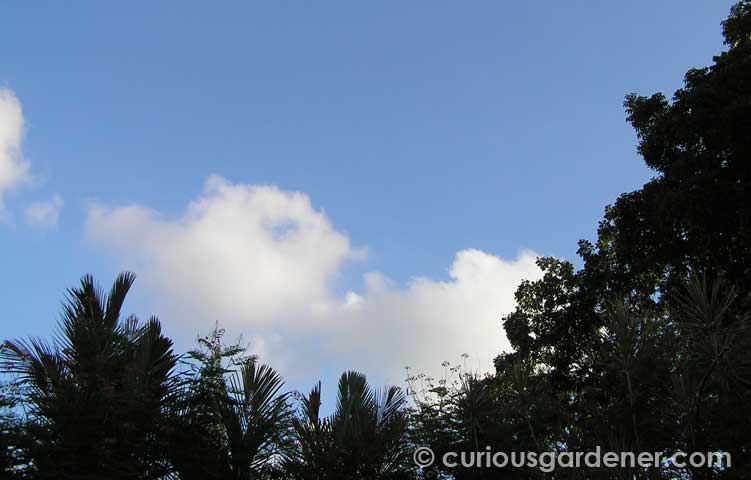Well of course the weather had to change the very day after I griped about how dry it’s been. Singaporeans woke up to the welcome sound of falling rain that next morning, which lasted several hours until early afternoon. I can only imagine the number of Tweets and other online postings about how happy everyone was about the welcome rain. Goodness knows I was one of them!
So, the weather has broken and the northeast monsoons are finally done. It’s funny how we tend to forget that “monsoon” refers to the winds, and not rainy weather. I think the earliest mention of the monsoons, for me, was in History and Geography classes in secondary school. What struck me strongest was the historical reference, because of how traders of yore had to depend on the flow of the winds to propel their ships. Way more exciting than wrapping my brain around land and sea temperatures and pressure patterns…

My most matured ginger plants to date enjoying the downpour. The ground may have looked flooded in this picture, but it quickly drained away when the rain tapered off. This must be testament to the dryness of the soil after weeks of dry winds.
Just for jollies, let’s just recap how the temperature of the land, when hot, attracts air from the sea, bringing moisture-laden air — and rain — with it. This would be summer in the northern hemisphere. The amount of rain decreases as the winds flow inward, because the clouds can only carry so much moisture for so long — that’s why Bangladesh gets hit by floods during the summer (it’s right on the coast), and why the weather at the tail end of the northeast monsoons is so dry.
Then, when the land cools towards the end of summer, the air changes direction to flow seaward, because the sea retains heat longer than land — and remember, heat rises and cold sinks, so the cool air rushes seaward to fill the space created by the rising warm air. These “winter” winds are dry because, hey, there isn’t as much water on land as at sea.
And the Eurasian (Europe & Asia) landmass, being such a huge chunk of land, is instrumental in creating the monsoons that blow in the region. It heats up in summer of the northern hemisphere and attracts the winds; it cools down in the latter half of the year and the winds begin to flow southward, to the sea and southern hemisphere. It’s almost like breathing, isn’t it? Inhale (NE monsoons), exhale (SW monsoons), inhale (NE ‘soons), exhale (SW ‘soons) — one unending cycle…
Of course, nature being nature, doesn’t always flow in straight lines, so neither do the NE and SW monsoons blow directly as they are named. Thanks to the geography of the region that splits and redirects the winds, we don’t experience 6 months of one monsoon and 6 months of the other. What we have are:
- N/NE monsoons from December to early March
- Inter-monsoon period from late March to May
- S/SE monsoons from June to September
- Inter-monsoon period from October to November
(If you want to learn more about Singapore’s weather and climate, visit the National Environment Agency (NEA)’s site and download this very nifty and informative booklet.)
Singapore, in the middle of the route of the monsoon winds, pretty much has warm weather interspersed with rain throughout the year — excepting of course, the inter-monsoon periods. That’s when the winds have pretty much run out of moisture in the air, and do nothing more than, well, blow.
© 2010 curiousgardener.com All rights reserved.




This is a very informative post! Thank you. =)
Would you mind if I linked back to it?
Be my guest!
Thank you!
Simply useful, I didn’t know NEA has made such resources available!